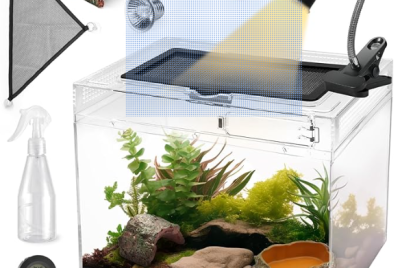Bearded Dragon Hydration Needs
Understanding Bearded Dragon Hydration Needs
Bearded dragons might look like rugged little dinosaurs, but when it comes to hydration, they’re surprisingly delicate. Ensuring your beardie stays properly hydrated is one of the most important aspects of their care. If you’re a proud dragon parent, you might wonder: how much water do they need, and what’s the best way to provide it?
Let’s dive into understanding their hydration needs, explore ways to keep them hydrated, and learn how to avoid common pitfalls.
Why Hydration Is Crucial for Bearded Dragons
Signs of Dehydration in Bearded Dragons
Dehydration is a silent threat. Look out for signs like wrinkled skin, sunken eyes, a lack of appetite, and sluggish behavior. Severe cases might even lead to health complications like kidney failure or impaction.
The Role of Hydration in Overall Health
Hydration does more than quench their thirst. It keeps their organs functioning, aids digestion, supports shedding, and prevents illnesses. Think of it as the oil that keeps the engine running smoothly—without it, your beardie’s entire system could falter.
Common Sources of Hydration for Bearded Dragons
Water Bowls: Do Bearded Dragons Really Drink?
Many bearded dragons don’t instinctively drink from a water bowl. This can leave you scratching your head, wondering if they’re getting enough water. It’s vital to keep the bowl clean and fresh to encourage them to take sips.
Hydrating Through Food: The Power of Vegetables and Fruits
Certain vegetables and fruits like cucumbers, zucchini, and watermelon can significantly boost their hydration. These foods are not only tasty but packed with water content. Adding these to their diet is an easy and effective way to ensure they’re staying hydrated.
Mist Sprays: Mimicking Natural Environments
Misting your beardie and its enclosure can simulate morning dew, which they might lap up in the wild. Plus, misting can help maintain proper humidity levels, which is crucial for their respiratory health.
Best Practices for Maintaining Proper Hydration
Choosing the Right Water Bowl for Your Beardie
Not all bowls are created equal. Opt for a shallow, stable dish that your dragon can easily access without fear of tipping it over. Place it in a low-traffic area of the enclosure to make it feel safe.
Bathing Techniques for Hydration
Baths aren’t just for cleanliness—they’re a hydration powerhouse! Soaking your dragon in lukewarm water a few times a week can encourage them to drink and absorb water through their skin.
Monitoring Humidity Levels in the Enclosure
Too much or too little humidity can spell trouble. Aim for a balanced environment with humidity levels between 30% and 40%. Use a hygrometer to monitor and adjust levels as needed.
Common Mistakes to Avoid
Avoid leaving stagnant water in the bowl for too long—it’s a breeding ground for bacteria. Over-misting can also create an overly humid environment, leading to respiratory issues. Finally, steer clear of over-relying on dry foods that offer little to no hydration.
The Importance of a Balanced Diet in Hydration
High-Water-Content Foods: What to Include
Leafy greens like collards and dandelion greens are excellent choices. Fruits like melons and berries can also make occasional treats that hydrate while delighting your beardie.
Foods to Avoid: Preventing Dehydration Risks
Avoid overly dry or salty foods, like certain processed insects. These can actually dehydrate your dragon instead of helping them. Stick to fresh, natural options.
How Seasonal Changes Affect Hydration Needs
In warmer months, your dragon may require more hydration due to increased activity and temperature. During brumation (a hibernation-like state), they may drink less but still need proper humidity to prevent dehydration.
Troubleshooting Hydration Challenges
Encouraging a Reluctant Dragon to Drink
If your dragon seems uninterested in drinking, try dripping water near its snout or using a syringe to offer water gently. Adding enticing smells, like fruit juice diluted in water, can also spark their interest.
When to Seek Veterinary Help
Persistent dehydration, even with proper care, may indicate underlying health issues. If your dragon exhibits severe dehydration signs or refuses hydration methods, consult a reptile-savvy vet.
Conclusion: Keeping Your Bearded Dragon Happy and Hydrated
Hydration is more than just keeping a water bowl handy—it’s about creating a holistic environment that supports their natural needs. By offering diverse hydration sources, monitoring their health, and avoiding common mistakes, you’ll ensure your beardie thrives. After all, a happy, hydrated dragon is a healthy one!
FAQs
- How often should I bathe my bearded dragon?
Aim for 2–3 times a week unless your vet advises otherwise. - Can bearded dragons drink tap water?
Yes, but it’s best to treat it with a reptile-safe water conditioner to remove chlorine and impurities. - Why doesn’t my bearded dragon drink from its water bowl?
Some dragons don’t recognize still water. Try misting or dripping water to encourage drinking. - What vegetables are best for hydration?
Cucumber, zucchini, and leafy greens like collards are excellent options. - Is misting every day necessary?
Not necessarily. Aim for 2–3 times a week, depending on the enclosure’s humidity levels.




